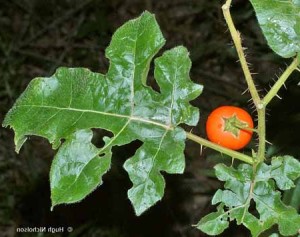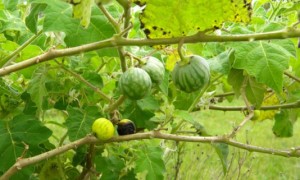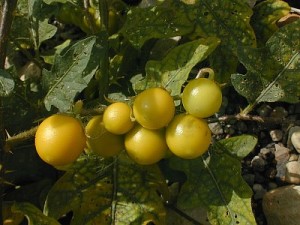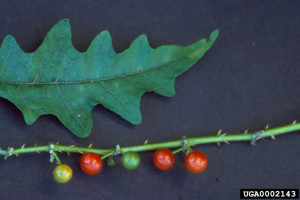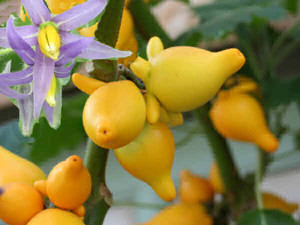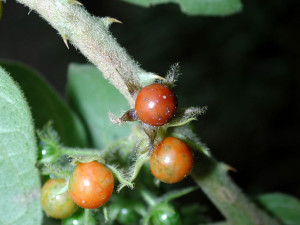I rarely write about toxic plants because this site is about edibles. However there are enough prickly nightshades around to justify an article about them and how to identify them even if they aren’t edible.
The Red Soda Apple, Solanum capsicoides, might be a native Floridian. Botanists can’t agree. It is now found in most warm areas of the world. Outside of North America S. capsidoides is often confused with Solanum aculeastissimum. Or… botanists being what they are… S. aculeastissimum and S. capsidoides might be the same species, or a close variation. At any rate it is a thorny, large-leafed plant to a yard high with spines all over it including the leaves, which can be shiny. The round green fruit resemble a striped water melon. When ripe it is red and slightly smaller than a ping-pong ball. One is safe saying the fruit is not edible because it certainly is toxic at some stage. Yet, one can find snippets of references here and there to the opposite. Usually they say the ripe flesh is edible but not the skin nor seeds which have the highest concentration of toxins. If the flesh is eaten it is only in small amounts. Loaded with steroids and precursors of steroid hormones it has been associated with abortions and other things steroids can do to your body. Ripe cut fruit is used as cockroach bait. Some botanists would argue S. aculeastissimum is African and all the nasty stuff is about that plant not S. capsicoides which they say is Brazilian. It is a dangerous family and best avoided. The easy answer is the Red Soda Apple is not edible. That is my position until someone can demonstrated in person otherwise.
The Tropical Soda Apple, Solanum viarum, is similar to the Red Soda Apple except its fruit turns bright yellow when ripe. And if I remember correctly the riper the fruit gets the more toxic it gets. And while it is similar-looking to the Red Soda Apple it’s oak-shaped leaves are dull green, never shiny. A lot more is written about the Tropical Soda Apple. For a toxic plant cattle and feral hogs spread the plant’s seeds around in their droppings. Growing to six feet high it has thorns on the tops sides of the leaves, underside of the leaves and all along the stem. It can grow year around as long as it stays warm. The blossoms are creamy white with petals and a yellow center. Its sweet-smelling fruit is one inch in diameter containing up to 400 brown seeds. The plant can produce some 50,000 seeds a year. They think its seeds came to south Florida in the tummies of cattle from Brazil around 1988. It became such an invasive that some ranchers were spending as much as 40% of their working time on controlling the plant costing some $16 million in 2007 dollars. Biological controls were implemented in 2003 with the release of Gratiana boliviana a beetle that only eats Tropical Soda Apple. It is currently found in Florida, Louisiana, Alabama, Mississippi, Georgia, South Carolina, North Carolina, Tennessee and Pennsylvania. All reports say it is toxic. Avoid it.
Horsenettle, Solanum Carolinense, is similar looking to the Tropical Soda Apple but is a smaller plant. The Tropical Soda Apple has larger leaves and long thorns and is more shrubby. Horsenettle flowers can be purple or white where Tropical Soda Apple has only white blossoms. And while the Horsenettle also has yellow fruit they tend to be wrinkled when ripe. The Horsenettle also has a potato-like odor when a leaf is crushed and the leaf stems are are covered with star-shaped hairs. Yellow fruits are half-enclosed in a paper calyx. The Horsenettle is found in most of the United States and Eastern Canada. It skips Nevada, Colorado, North Dakota, Montana and all of Canada west of Ontario. Not edible. A close relative, the Robust Horsenettle (Solanum dimidiatum) which has rounder leaves than the Horsenettle, also is not edible.
The Aquatic Tropical Apple, Solanum tampicense, typically prefers wetlands. Much of southwest Florida have been invaded by it. Once established, it forms large, tangled, dense stands along river banks, cypress swamps, open marsh, and relatively undisturbed wetlands. It’s native to the West Indies, Mexico, and Central America and blooms in the fall. A straggly, sprawling prickly shrub, woody below, herbaceous above, has green stems to 16 feet long. Leaves: Alternate, simple, leafs longer than wide, 10-inches wide, three inches wide deeply round-indented edges, recurved or straight prickles on veins, and stellate hairs. Flowers are small, three to 11 individual flowers in stalked, branched clusters at leaf axils. Petals are white; stamens with yellow anthers held closely and erect in center of flower. Fruit: A small, spherical, tomato-like berry to almost half-an-inch, shiny solid green turning orange then bright red at maturity, with 10 to 60 yellowish, flat-round seeds. Not edible.
Among the more unusual prickly non-edibles is the Nipplefruit Nightshade, Solanum mammosum. While it is naturalized in Puerto Rico it also escaped from back yards in peninsula Florida south coastal Texas. I’m not quite sure why one would plant it. Not edible, prickly, and irregular in flowering and fruiting. The fruit contains solanine saponine, mallic and gallic acids, and solamargine, a glycoalkaloid. It is purgative. There is one Malaysian report that the unripe fruit is edible. I’d have to see it to believe it. The plant resembles a thorny eggplant but can grow to the size of a small tree.
The Jamaican Nightshade (Solanum jamaicense) is found in only a few central Florida counties. It’s a prickly, perennial, invasive shrub in central and southern peninsular Florida and was first seen in the state in 1930 near St. Cloud. Jamaican nightshade is usually found in woodlands where it can dominant the understory. Occasionally it grows in isolated patches in the open. Like other nightshades in this article it is armed with short curved spines. Leaves are in subequal pairs, with dense stellate hairs, somewhat diamond-shaped, flowers white, yellow anthers; fruit is an red-orange berry to about a third of an inch.
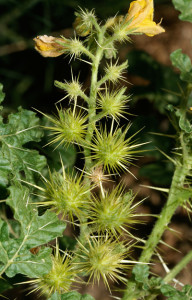
The Toxic Buffalobur. photo by FireflyForest
Very few people would mistake the Buffalobur, Solanum rostratum, as edible but it is a prickly, toxic nightshade often seen. The small fruit is totally encased in a spiny calyx. It is an erect, branching annual found in fields, pastures, fence rows, roadsides and wastes sites. The leaves have with prominent white veins. The plants, especially the leaves and green fruit, are poisonous and contain the glycoalkaloid solanine as well as other tropane alkaloids. The plants can also accumulate toxic levels of nitrates from the soil. Stinging or Itching – The numerous sharp spines on the plants and burs can cause intense, lingering pain if touched. Animals are also affected, and even after the burs are removed, dogs will continue to lick and chew on their feet because of the pain.
Before we move on to an edible prickly nightshade, why the term “soda apple?” Soda through Middle English, Middle French and Middle Latin is probably from the Arabic word Suwwad (saltwort) which was a plant alkaloids were gotten from perhaps for soap making. And most of these non-edible plants have alkaloids. So instead of thinking Soda Apple or Tropical Soda Apple think Alkaloid Apple, a good reason to avoid said. Lastly there is one local prickly Solanum that is a tomato and definitely edible, the Litchi tomato. To read more about it go here. There is also a lesser edible, the Turkey Berry, read about it go here.
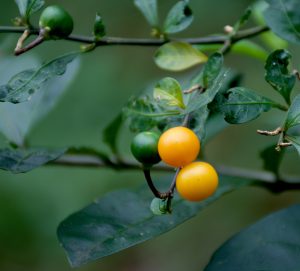
The controversial two-leaf nightshade. Photo by Green Deane
And what are we to do with the Two-Leaf Nightshade, Solanum diphyllum? This native to Mexico and Central America was first spied in the United States in Miami in the early to mid-1960s. It has spread since then and is a common shrub in south and Central Florida as well as parts of Texas and in southern France, Italy and Taiwan. It’s almost always reported as toxic. I wrote “almost” because some people say they have eaten a few ripe berries without noticeable issue. Our usual sources of plant expertise are no help with this greenery: Daniel Austin in his tome Florida Ethnobotany doesn’t mention the plant though he was a professor of botany in south Florida when the species was proliferating. His University of Miami boss, the crusty Julia Morton, doesn’t do us much better.
In her book Plants Poisonous To People in Florida she calls it Amatillo. Instead of having it in the main section of the book it’s in the back under “other toxins.” After a description she writes: “The ripe fruit is sweetish, not acrid like the Jerusalem Cherry, but the green fruit and leave probably contain solanine.” She adds “In one pasture, where there were several of these bushes, a horse had optical abnormality, was staggering and weak in the hindquarters and may have grazed on the foliage.” I think that means don’t eat the leaves. Morton finishes her entry with “We must regard it with suspicion until we have actual evidence of toxicity.” I would add the species in not mentioned in the Journal of Economic Botany which spans some seven decades and was created to bring lesser-known plants to public attention and use. I know several people who eat a few of the ripe fruits at a time. I have eaten two at a time, several times, and as far as I know it as not bothered me. If you have arthritis avoid the ripe fruit. Solanine is known to aggravate arthritis.

